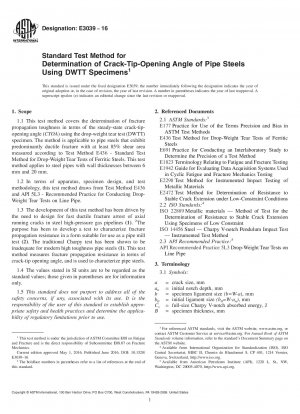ASTM E3039-16
Standard Test Method for Determination of Crack-Tip-Opening Angle of Pipe Steels Using DWTT Specimens
- Standard No.
- ASTM E3039-16
- Release Date
- 2016
- Published By
- American Society for Testing and Materials (ASTM)
- Status
- Replace By
- ASTM E3039-18
- Latest
- ASTM E3039-20
- Scope
1.1 This test method covers the determination of fracture propagation toughness in terms of the steady-state crack-tip-opening angle (CTOA) using the drop-weight tear test (DWTT) specimen. The method is applicable to pipe steels that exhibit predominantly ductile fracture with at least 85% shear area measured according to Test Method E436 - Standard Test Method for Drop-Weight Tear Tests of Ferritic Steels. This test method applies to steel pipes with wall thicknesses between 6 mm and 20 mm.
1.2 In terms of apparatus, specimen design, and test methodology, this test method draws from Test Method E436 and API 5L3 - Recommended Practice for Conducting Drop-Weight Tear Tests on Line Pipe.
1.3 The development of this test method has been driven by the need to design for fast ductile fracture arrest of axial running cracks in steel high-pressure gas pipelines (1). 2The purpose has been to develop a test to characterize fracture propagation resistance in a form suitable for use as a pipe mill test (2). The traditional Charpy test has been shown to be inadequate for modern high toughness pipe steels (1). This test method measures fracture propagation resistance in terms of crack-tip opening angle, and is used to characterize pipe steels.
1.4 The values stated in SI units are to be regarded as the standard values; those given in parentheses are for information only.
1.5 This standard does not purport to address all of the safety concerns, if any, associated with its use. It is the responsibility of the user of this standard to establish appropriate safety and health practices and determine the applicability of regulatory limitations prior to use.
ASTM E3039-16 Referenced Document
- ASTM E177 Standard Practice for Use of the Terms Precision and Bias in ASTM Test Methods
- ASTM E1823 Standard Terminology Relating to Fatigue and Fracture Testing
- ASTM E1942 Standard Guide for Evaluating Data Acquisition Systems Used in Cyclic Fatigue and Fracture Mechanics Testing
- ASTM E2298 Standard Test Method for Instrumented Impact Testing of Metallic Materials
- ASTM E2472 Standard Test Method for Determination of Resistance to Stable Crack Extension under Low-Constraint Conditions
- ASTM E436 Standard Test Method for Drop-Weight Tear Tests of Ferritic Steels
- ASTM E691 Standard Practice for Conducting an Interlaboratory Study to Determine the Precision of a Test Method
- ISO 14456 Gas cylinders — Gas properties and associated classification (FTSC) codes
- ISO 22889 Metallic materials.Method of test for the determination of resistance to stable crack extension using specimens of low constraint
ASTM E3039-16 history
- 2020 ASTM E3039-20 Standard Test Method for Determination of Crack-Tip-Opening Angle of Ferritic Steels Using DWTT-Type Specimens
- 2018 ASTM E3039-18e1 Standard Test Method for Determination of Crack-Tip-Opening Angle of Pipe Steels Using DWTT-Type Specimens
- 2018 ASTM E3039-18 Standard Test Method for Determination of Crack-Tip-Opening Angle of Pipe Steels Using DWTT-Type Specimens
- 2016 ASTM E3039-16 Standard Test Method for Determination of Crack-Tip-Opening Angle of Pipe Steels Using DWTT Specimens
